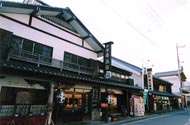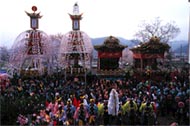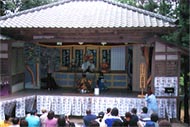|
|
History
Find out how
the art form developed and what makes it unique. |
| Ogano in suburban Tokyo is
known as a town where "everyone is a kabuki actor." Local residents have
kept alive a kabuki-performing tradition that goes back over a century.
Youngsters are part of this tradition as well and stage a full-fledged drama
with an assortment of costumes, wigs, and props. |
| The town of Ogano
is approximately 100 kilometers (62 miles) northwest of Tokyo. It's
a quiet community of 12,500 people in Saitama Prefecture, surrounded
by low-lying mountains. It developed as a center of silk production
and commerce several centuries ago, and traces of its rich past
can still be seen in the old-style inns and shops near the middle
of town. |
|
|
| Ogano is also
noted for a unique type of kabuki performed by the town's residents.
Legend has it that this began in the late Edo period (1603-1868)
when aspiring kabuki actors who finished their apprenticeship in
Edo (now Tokyo) returned to Ogano to teach the local townspeople
this stage art. |
|
|
| Kabuki is a form of classical
theater that evolved in the early seventeenth century. It's characterized
by extravagant costumes and flamboyant makeup (kumadori)
that accentuate the character's personality and mood. It has a distinctive
type of delivery, rising and falling in tone, and uses defiant poses
(mie) to express heights of emotion. Most plays draw on medieval
or Edo-period themes. |
|
| In the world
of professional kabuki, most actors are born into kabuki-performing
families, and only males are allowed on stage. Locally performed
kabuki, like the one in Ogano, are open to all residents. Ogano
has three separate performing groups comprising men, women, and
children. With the advent of movies and television, the popularity
of Ogano kabuki had been declining, but in 1973, a preservation
society was formed to reverse this trend. Since then, it has gradually
been winning back fans. |
|
|
| Ogano kabuki
is supported by a longstanding tradition. Even among some 150 types
of locally performed kabuki nationwide, Ogano's production is unique
for being completely self-sufficient. It has all the necessary performers,
backstage hands, wigs, costumes, sets, props, and musical instruments
to stage a performance. |
|
|
| There are five performing
centers within Ogano, each with its own stage. The number of residents
who are actively involved in kabuki, both as performers and members
of the supporting staff, is around 230. The figure is much higher
when people who were involved at one time or another are also counted.
This is why Ogano is known as a town where "everyone is a kabuki
actor." |
|
| Photos (from top): The town of Ogano, tucked away among low-lying
mountains; An inn in downtown Ogano that retains the look of a bygone
era; The local spring festival is one of the biggest events of the
year; Outdoor kabuki stages can be found in various sections of
the town. |
|




